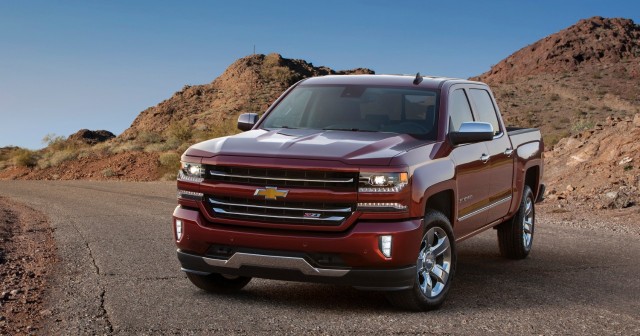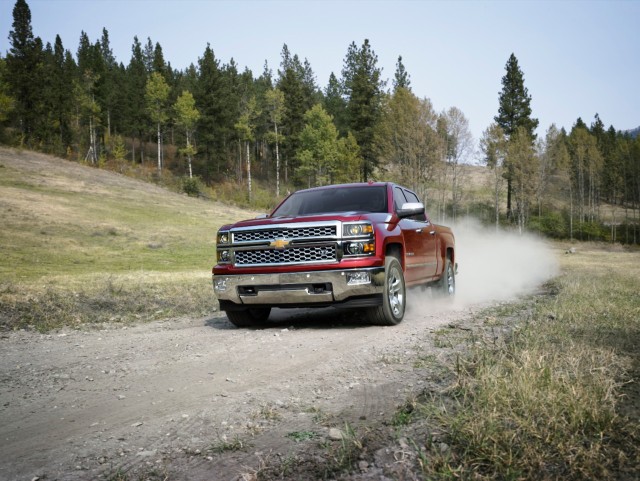THE MOST DANGEROUS GAME.
 Tuesday, July 14, 2015 at 02:43PM
Tuesday, July 14, 2015 at 02:43PM By Peter M. De Lorenzo
Detroit. When GM took the wraps off of its 2014 Chevrolet Silverado pickup truck, Chevrolet PR minions generated the usual noise at intro suggesting that this truck would indeed “set the new standard.” And in fact it was a better truck by every measure than the model that came before it, except for one glaring deal breaker: It simply didn’t look new. Instead, it looked like a minor freshening, nothing more than a re-hash of a familiar theme.
At this point Chevrolet loyalists down at the Silver Silos are probably clamoring to point out that it didn’t matter, that the truck sold just fine anyway. But who’s kidding whom here? The fact that the truck didn’t look new enough in a cutthroat pickup segment that would be crawling with “new” over the ensuing 24 months was more than a little hiccup; it was a major league screw-up that cost Chevrolet sales.
How major? Chevrolet has unveiled a completely new front-end design for the Silverado that will debut for the 2016 model year this fall. And this is no minor “freshening” either. In fact, it’s a complete re-think. (It should be pointed out that it didn’t exactly help matters much that Chevrolet’s mid-size pickup – the Colorado - looked better in the flesh right out of the gate, making the Silverado appear to be a stale afterthought.)
The decision to do a crash re-design of GM’s most profitable vehicle came quickly, not more than six months after introduction, because the buzz on the street was a giant, steaming bowl of Not Good. Sure, Chevy loyalists bought the truck, but the design of the 2014 Silverado quickly reached the point of diminishing returns in the market, and in no time it was yesterday’s news. And in this business that’s a death-knell.
How could this have happened? How could GM Design, which for the most part has been on a notable roll of late, miss the opportunity given to them by that much? As you’ll see, it’s a sad, sordid tale that gets to the very heart of this business, but in essence, GM played small ball with the Silverado and got burned.
GM, of course, researched the new truck to the nth degree and promptly bought into the idea hook, line and sinker that truck buyers were naturally conservative and didn’t need the new Silverado to be all that new or different - just better. This was not unexpected feedback in the least, in fact it’s so typical – and predictable – in the pickup segment that companies shouldn’t even have to ask the question. But by letting conservatism reign over the design brief, thus taking the path of least resistance, GM deservedly took it on the chin with the new Silverado, with the consumer – and dealer – reaction being more of, “That’s the new one?” instead of “Wow!”
And therein lies one of the great mysteries of the Autoverse: Interpreting consumer feedback when it comes to design “reach” is the most dangerous game played in this business. Design “clinics” for consumers can yield crucial information there’s no doubt, but it’s in the interpretation of that feedback that can make or break a new vehicle.
Needless to say the plot can get lost in a hurry, especially if the people making the decisions lack conviction, or are inveterate wafflers or even worse, spineless weasels. Not that it’s an easy process by any means, because making the “go” or "no-go” decision about a vehicle’s design can be the most gut-wrenching moment in this business. For the key players involved getting it right means you’re going to be a hero for life. Conversely, getting it wrong means that you’re going to have to crawl your way back to respectability, and in this business there are no guarantees that will happen.
Listening to consumers is but one thing to consider, however, and placing too much emphasis on what they say in design clinics is usually a recipe for disaster. Why? Because if a car company puts too much emphasis on that ingrained conservatism, it ends up burying the concept of “design reach” in excuses, and the resulting mayhem usually manifests itself in a design that lays flat in the market.
Some people refuse to acknowledge this but the automobile business is a fashion business, pure and simple. And the designers involved are some of the most brilliant and creative people in the business. “Design reach” is what they’re paid – and handsomely, I might add – to do, so subjugating design decisions to reactionary, aim-low consumers or marketing hand-wringers is a fool’s errand.
GM’s second design chief, the legendary Bill Mitchell, knew this instinctively and implicitly. He set the tone for this business, as much if not more than the top fashion designers of today hold sway over their visionary specialties.
An absolute genius at bringing “design reach” to life, Mitchell never shirked at pushing the envelope. His specialty was bringing concept car looks to the highways and byways of mainstream America. And as was his wont, he didn’t much care what consumers said they wanted, because inevitably they didn’t know what they wanted until they saw it on the street and mumbled something like, “Me. Want.” It was his job to tell them what they needed, and no one was better at it then or since.
The decision makers involved in the design of the 2014 Silverado got it wrong, big time. They should have cranked one out to deep center field; instead they dribbled a feeble grounder down the third base line. Comfortable predictability took the driver’s seat, while the bold, exuberant design point of view was left standing like a house by the side of the road.
As I’ve said many, many times over the last sixteen years of writing this column, design remains the Ultimate Product Differentiator, and its importance grows with each passing model year. With the democratization of technology and luxury, design remains the most powerful, emotionally compelling reason for buying.
After all of this, it’s somewhat amusing to see what Chevy’s PR minions are saying about the 2016 Silverado…
“A bolder, more sculpted look reflects Silverado strength.”
Too bad the powers that be involved at Chevrolet didn’t heed those words the first time.
And that’s the High-Octane Truth for this week.
 (GM photo)
(GM photo)
The 2016 Chevrolet Silverado coming this fall.
 (GM Photo)
(GM Photo)
The current Chevrolet Silverado.




